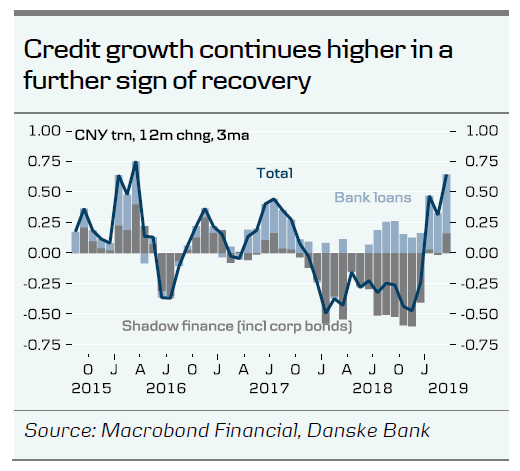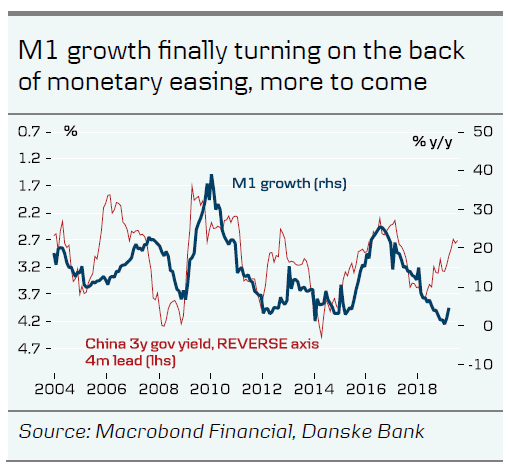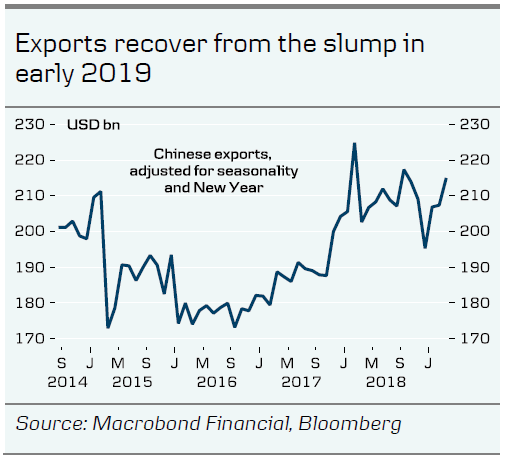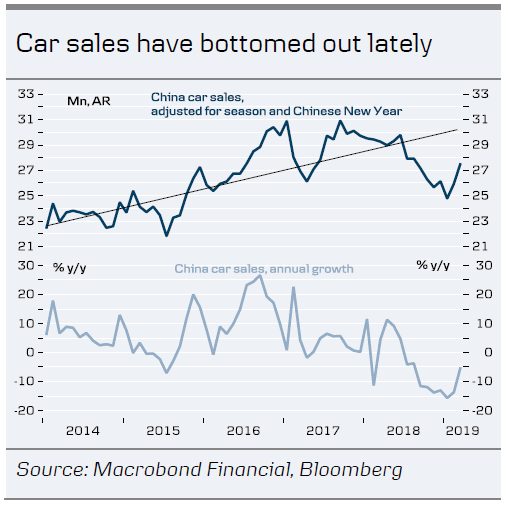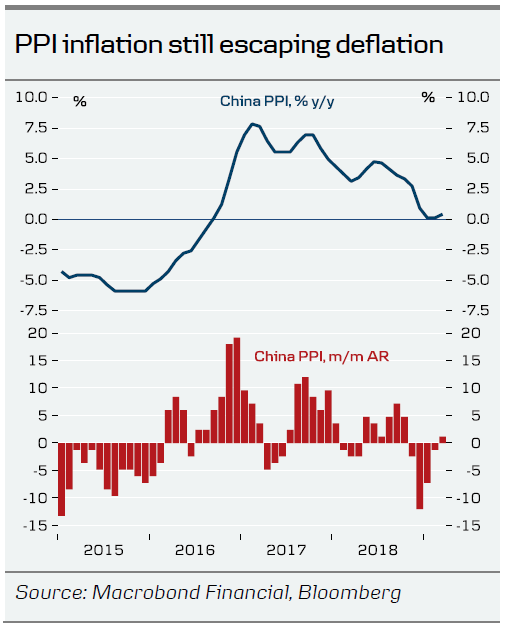- Recovery signs continue as exports, car sales, credit and money growth all revive in March
- IMF lifts the 2019 growth forecast for China from 6.2% to 6.3%
- US and China clear an important roadblock in trade talks as the two sides agree on an enforcement mechanism
- March data surprise to the upside across the board
The positive news flow on the Chinese economy continued this week . Credit growth moved higher in March and grew at the strongest pace since 2015 (see chart). Both bank lending and shadow finance contributed to the increase. M1 growth moved higher to 4.6% y/y in March from 3.0% y/y in February. Exports rebounded as well, beating expectations with a rise of 14.2% in March (consensus 6.3% y/y). Finally car sales edged higher, breaking a string of negative surprises (see chart next page).
On the inflation side producer price inflation increased on a monthly basis after declining for four months in a row. It generally reflects the rise in industrial commodity prices lately but is positive for industrial profits.
The IMF released its spring forecasts this week. While growth was revised lower for most countries, China was the outlier as the IMF lifted the forecast for 2019 to 6.3% from 6.2%. The revision was based on changed assumptions for US tariffs. The tariff the rate on USD200bn of Chinese goods was kept at 10% as part of the ceasefire deal instead of rising to 25% as assumed in the previous forecast. For 2020 the IMF estimate was lowered to 6.1% from 6.2%.
Comment. The string of positive March numbers confirm the recovery signal from PMIs and metal markets . There may be some overshooting in March as it is difficult to correct fully for the Chinese New Year effect. But given how broad the improvement is across exports, industry, service and consumer numbers it is getting more likely that a gradual recovery has begun. Stimulus is kicking in and uncertainty from trade tensions has started to ebb. We get Q1 GDP growth next week, which will probably show further slowing to 6.3% y/y from 6.4% y/y in Q4. But we expect this to be the bottom in this cycle.
Agreement on enforcement mechanism a milestone in talks
US and China continue to talk ‘ around the clock’ according to US Treasury Secretary Stephen Mnuchin. In an interview with CNBC on Wednesday, he said that trade talks were ‘ very productive’ and that the US and China had ‘ pretty much agreed on an enforcement mechanism’ . According to Mnuchin, the two sides will establish enforcement offices that will deal with the ongoing matters.
On the issue of whether tariffs would stay in place, he would not comment on which would stay and which would go. This revealed though that some tariffs will likely be removed.
On the timing and scope of a deal, Mnuchin stated that they are working on a 150-page document and that it is more important to get the right deal than to set an ‘arbitrary deadline‘. If a deal is done, Mnuchin expressed that ‘this will be the most significant changes to the economic relationship between US and China in the last 40 years‘ and that the opening of the Chinese economy will give ‘tremendous opportunities‘ for US companies.
Comment. The enforcement mechanism has been one of the key obstacles in the trade talks and the agreement in this area is a big step closer to a deal, see SCMP 11 April for more colour on this. The main sticking point now seems to be how many tariffs will stay in place and how many will be removed. Trump said two weeks ago that all tariffs would stay on for some time. However, China is unlikely to accept this and Mnuchin’s comments suggest that the US is ready to remove some of the tariffs. The timing of a deal is still uncertain but our best guess right now is that a deal will emerge within 4-6 weeks.
Other selected China news of the week
The improving data have pushed up bond yields as the expectation of further monetary stimulus is being scaled back. Stock markets have had a volatile week but the pullbacks in the market tend to be quite short-lived despite already strong gains this year. It suggests to us that there is still appetite to buy into Chinese equities on the expectation of a recovery and that the increasing weight in MSCI will drive inflows into the A-share market.
USD/CNY has moved sideways in a very tight range around 6.71 since the middle of February. It could very well be a deliberate attempt by China to keep the currency stable to underpin the positive spirit in the trade talks.
China’s Premier Li Keqiang promised further reforms at the EU-China Summit this week, see SCMP 10 April. ‘When we say it, we have got to do it‘ he said. The summit ended with a joint statement, posted on the European Council website, which among other things stated that ‘the high level of ambition will be reflected in substantially improved market access, the elimination of discriminatory requirements and practices affecting foreign investors‘.
China and Malaysia agree to restart the construction of the East Coast Rail Line, a part of China’s Belt and Road Initiative, see Reuters 12 April. The project was put on hold by the 93-year old Prime Minister Mahathir Mohamad after he regained power in May. The two sides agreed to cut the cost to USD10.7bn from originally close to USD16bn.
For those interested in tech and AI this article on visualcapitalist.com has an excellent infographic on the development within AI with lots of details on the global AI landscape.




